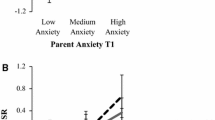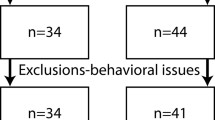Abstract
Anxiety has been proposed to influence psychophysiological reactivity in children and adolescents. However, the extant empirical literature has not always found physiological reactivity to be associated with anxiety in youth. Further, most investigations have not examined psychophysiological reactivity in real time over the course of acute stress. To test the impact of anxiety disorder status on autonomic arousal in youth, we compared youth with primary anxiety disorders (N = 24) to typically developing (TD) youth (N = 22) on heart rate (HR), heart rate variability (HRV), and respiratory sinus arrhythmia (RSA) during an acute stressor in which youth received error-related feedback. We also conducted exploratory analyses on youth performance during the task. Youth ages 9–17 participated in the arithmetic portion of the Trier Social Stress Test for Children (Buske-Kirschbaum et al., Psychosom 59:419–426, 1997), during which time they received consecutive, standardized feedback that they made calculation errors. Results indicated that, compared to their TD counterparts, the anxious group demonstrated elevated HR and suppressed HRV during initial provision of error feedback and during the recovery period. No group differences were found for RSA. Additionally, overall TD youth made a greater proportion of errors than anxious youth. Clinically, these findings may provide preliminary support for anxious youth exhibiting physiological reactivity in response to receipt of error-related feedback, and may have implications for understanding biological processes during stress. This work underscores the need for further study of when and how anxiety may influence autonomic reactivity over the course of stress.



Similar content being viewed by others
References
Costello EJ, Egger H, Angold A (2005) 10-year research update review: the epidemiology of child and adolescent psychiatric disorders: I. Methods and public health burden. J Am Acad Child Adolesc Psychiatry 44:972–986. doi:10.1097/01.chi.0000172552.041596.6f
Bittner A, Egger HL, Erkanli A, Costello JE, Foley DL, Angold A (2007) What do childhood anxiety disorders predict? J Child Psychol Psychiatr 48:1174–1183. doi:10.1111/j.1469-7610.2007.01812.x
Sherrill JT (2008) Commentary: expanding the research agenda on interventions for child and adolescent anxiety disorders. Cogn Behav Pract 15:166–171. doi:10.1016/j.cbpra.2007.11.002
Beesdo K, Knappe S, Pine DS (2009) Anxiety and anxiety disorders in children and adolescents: devleopmental issues and implications for DSM-V. Psychiatr Clin North Am 32:483–542. doi:10.1016/j.psc.2009.06.002
Pine DS, Cohen P, Gurley D, Brook J, Ma Y (1998) The risk for early-adulthood anxiety and depressive disorders in adolescents with anxiety and depressive disorders. Arch Gen Psychiatr 55:56–64. doi:10.1001/archpsyc.55.1.56
March JS (2011) Looking to the future of research in pediatric anxiety disorders. Depress Anxiety 28:88–98. doi:10.1002/da.20754
Pine DS (2007) Research review: a neuroscience framework for pediatric anxiety disorders. J Child Psychol Psychiatr Allied Discip 48:631–648. doi:10.1111/j.1469-7610.2007.01751.x
Barlow DH (2000) Unraveling the mysteries of anxiety and its disorders from the perspective of emotion theory. Am Psychol 55:1247–1263. doi:10.1037/0003-066x.55.11.1247
Clarke LA, Watson D (1991) Tripartite model of anxiety and depression: psychometric evidence and taxonomic implications. J Abnorm Psychol 100:316–336. doi:10.1037/0021-843x.100.3.316
Weems CF (2008) Developmental trajectories of childhood anxiety: identifying continuity and change in anxious emotion. Dev Rev 28:488–502. doi:10.1016/j:dr.2008.01.001
Blechert J, Michael T, Williams SL, Purkis HM, Wilhelm FH (2008) When two paradigms meet: does evaluative learning extinguish in differential fear conditioning? Learn Motivation 39:58–70. doi:10.1016/j.lmot.2007.03.003
Craske MG, Kircanski K, Zelikowsky M, Mystkowski J, Chowdhury N, Baker A (2008) Optimizing inhibitory learning during exposure therapy. Behav Res Ther 46:5–27. doi:10.1016/j.brat.2007.10.003
Lau JYF, Lissek S, Nelson EE, Lee Y, Roberson-Nay R, Poeth K et al (2008) Fear conditioning in adolescents with anxiety disorders: results from a novel experimental paradigm. J Am Acad Child Adolesc Psychiatr 47:94–102. doi:10.1097/chi.0b01e31815a5f01
Kossowsky J, Wilhelm FH, Roth WT, Schneider S (2012) Separation anxiety disorder in children: disorder-specific responses to experimental separation from the mother. J Child Psychol Psychiatr 53:178–187. doi:10.1111/j.1469-7610.2011.02465.x
Rozenman M, Vreeland A, Piacentini J (2017) Thinking anxious, feeling anxious, or both? Cognitive bias moderates the relationship between anxiety disorder status and sympathetic arousal in youth. J Anx Disord 45:34–42. doi:10.1016/j.janxdis.2016.11.004
Kramer M, Seefeldt WL, Heinrichs N, Tuschen-Caffier B, Schmitz J, Wolf OT et al (2011) Subjective, autonomic, and endocrine reactivity during social stress in children with social phobia. J Abnorm Child Psychol 40:95–104. doi:10.1007/s10802-011-9548-9
Schmitz J, Kramer M, Tuschen-Caffier B, Heinrichs N, Blechert J (2011) Restricted autonomic flexibility in children with social phobia. J Child Psychol Psychiatr 52:1203–1211. doi:10.1111/j.1469-7610.2011.02417.x
Alkozei A, Cresswell C, Cooper P, Allen J (2015) Autonomic arousal in childhood anxiety disorders: associations with state anxiety and social anxiety disorder. J Affect Disord 175:25–33. doi:10.1016/j.jad.2014.11.056
Anderson E, Hope D (2009) The relationship among social phobia, objective and perceived physiological reactivity, and anxiety sensitivity in an adolescent population. J Anx Disord 23:18–26. doi:10.1016/j.janxdis.2008.03.011
Dorn L, Campo J, Thato S, Dahl R, Lewin D (2003) Psychological comorbidity and stress reactivity in children and adolescents with recurrent abdominal pain and anxiety disorders. J Am Acad Child Adolesc Psychiatr 42:66–75. doi:10.1097/00004583-200301000-00012
Schmitz J, Tuschen-Caffier B, Wilhelm F, Blechert J (2013) Eur Child Adolesc Psychiatr 22:631–640. doi:10.1007/s00787-013-0405-y
Miers A, Blote A, Sumter S, Kallen V (2011) Subjective and objective arousal correspondence and the role of self-monitoring processes in high and low socially anxious youth. J Exp Psychopathol 18:322–333. doi:10.5127/jep.019411
Schmitz J, Blechert J, Kramer M, Asbrand J, Tuschen-Caffier B (2012) Biased perception and interpretation of bodily anxiety symptoms in childhood social anxiety. J Clin Child Adolesc Psychol 41:92–102. doi:10.1080/15374416.2012.632349
Buske-Kirschbaum A, Jobst S, Wustmans A (1997) Attenuated free cortisol response to psychosocial stress in children with atopic dermatitis. Psychosom 59:419–426. doi:10.1087/00006842-199707000-00012
Reynolds G, Field A, Askew C (2014) Effect of vicarious fear learning on children’s heart rate responses and attentional bias for novel animals. Emot 14:995–1006. doi:10.1037/a0037225
Askew C, Hagel A, Morgan J (2015) Vicarious learning of children’s social-anxiety-related fear beliefs and emotional Stroop bias. Emot 15:501–510. doi:10.1037/emo00000083
Kramer M, Schmitz J, Heinrichs N, Tuschen-Caffier B (2011) Self-evaluation, social and cognitive performance in children with social phobia. J Exp Psychopathol 2:586–600. doi:10.5127/jep.0016311
Miers AC, Blote AW, de Rooij M, Bokhorst CL, Westenberg PM (2013) Trajectories of social anxiety during adolescence: relations with cognition, social competence, and temperament. J Abnorm Child Psychol 41:97–110. doi:10.1007/s10802-012-9651-6
Ashcraft MH, Faust MW (1994) Mathematics anxiety and mental arithmetic performance: an exploratory investigation. Cog Emot 8:97–125. doi:10.1080/02699939408408931
Eysenck MW, Calvo MG (1992) Anxiety and performance: the processing efficiency theory. Cog Emot 6:409–434. doi:10.1080/02699939208409696
Owens M, Stevenson J, Norgate R, Hadwin JA (2008) Processing efficiency theory in children: working memory as a mediator between trait anxiety and academic performance. Anx Stress Coping 21:417–430. doi:10.1080/10615800701847823
Chalmers JA, Quintana DS, Abott MJA, Kemp AH (2014) Anxiety disorders are associated with reduced heart rate variability: a meta-analysis. Front Psychiatr 5:80. doi:10.3389/fpsyct.2014.00080
Friedman BH (2007) An autonomic flexibility-neurovisceral integration model of anxiety and cardiac vagal tone. Biol Psychol 74:185–199. doi:10.1016/j.biopsycho.2005.08.009
Graziano P, Derefinko K (2013) Cardiac vagal control and children’s adaptive functioning: a meta-analysis. Biol Psychol 94:22–37. doi:10.1016/j.biopsycho.2013.04.011
Walkup J, Albano A, Piacentini J, Birmaher B, Compton SN, Sherrill JT et al (2008) Cognitive behavioral therapy, sertraline, or a combination in childhood anxiety. New Engl J Med 359:2753–2766. doi:10.1056/NEJMoa0804633
Silverman W, Albano A (1996) Anxiety disorders interview schedule for children-IV. Psychological Corporation, San Antonio
Silverman W, Saavedra L, Pina A (2001) Test-retest reliability of anxiety symptoms and diagnoses with the anxiety disorders interview schedule for DSM-IV: child and parent versions. J Am Acad Child Adolesc Psychiatr 40:937–944. doi:10.1097/00004583-200108000-00016
Wood JJ, Piacentini JC, Bergman RL, McCracken J, Barrios V (2002) Concurrent validity of the anxiety disorders section of the anxiety disorders interview schedule for DSM-IV: child and parent versions. J Clin Child Adolesc Psychol 31:335–342. doi:10.1207/S15374424JCCP3103_05
Kirschbaum C, Pirke KM, Helhammer DH (1993) The ‘Trier Social Stress Test’—a tool for investigating psychobiological stress responses in a laboratory setting. Neuropsychobio 28:76–81. doi:10.1159/000119004
Aldao A, McLaughlin KA, Hatzenbuehler ML, Sheridan MA (2014) The relationship between rumination and affective, cognitive, and physiological responses to stress in adolescents. J Exp Pscychopathol 5:272–288. doi:10.5127/jep.039113
Gilissen R, Bakermans-Kranenburg MJ, van Ijzendoorn MH, Linting M (2008) Electrodermal reactivity during the Trier Social Stress Test for children: interaction between the serotonin transporter polymorphism and children’s attachment representation. Dev Psychobio 50:615–625. doi:10.1002/dev.20314
Kudielka BM, Buske-Kirschbaum A, Hellhammer DH, Kurschbaum C (2004) HPA axis responses to laboratory psychosocial stress in healthy adults, younger adults, and children: impact of age and gender. Psychoneuroendocrinol 29:83–98. doi:10.1016/S0306-4530(02)00146-4
Silvetti MS, Drago F, Ragonese P (2001) Heart rate variability in healthy children and adolescents is partially related to age and gender. Int J Cardiol 81:169–174. doi:10.1016/S0167-5273(01)00537-x
Burkholder AR, Koss KJ, Hostinar CE, Johnson AE, Gunnar MR (2016) Early life stress: effects on the regulation of anxiety expression in children and adolescents. Soc Dev 25:777–793. doi:10.1111/sode.12170
Lang PJ, Davis M, Öhman A (2000) Fear and anxiety: animal models and human cognitive psychophysiology. J Affect Disord 61:137–159. doi:10.1016/S0165-0327(00)00343-8
Steimer T (2002) State of the art: the biology of fear- and anxiety-related behavior. Dialogues Clin Neurosci 4:231–249
Gentzler AL, Snatucci AK, Kovacs M, Fox NA (2009) Respiratory sinus arrhythmia reactivity predicts emotion regulation and depressive symptoms in at-risk and control children. Biol Psychol 82:156–163. doi:10.1016/j.biopsycho.2009.07.002
Field AP, Schorah H (2007) The verbal information pathway to fear and heart rate changes in children. J Child Psychol Psychiatr 48:1088–1093. doi:10.1111/j.1469-7610.2007.01772.x
Kudielka BM, Hellhammer DH, Kirschbaum C, Harmon-Jones E, Winkielman P (2007) Ten years of research with the Trier Social Stress Test—revisited. Social neuroscience: Integrating biological and psychological explanations of social behavior, pp 56–83
Acknowledgements
This work was supported by the UCLA Research Program for Psychobiological Sciences T32 MH 17140 (Leuchter) and the UCLA Clinical Translational Science Institute UL1TR000124 (Rozenman). The authors would like to acknowledge and thank the children and their parents who participated in this research.
Author information
Authors and Affiliations
Corresponding author
Ethics declarations
Conflict of interest
The authors report no conflicts of interest for the current work.
Rights and permissions
About this article
Cite this article
Rozenman, M., Sturm, A., McCracken, J.T. et al. Autonomic arousal in anxious and typically developing youth during a stressor involving error feedback. Eur Child Adolesc Psychiatry 26, 1423–1432 (2017). https://doi.org/10.1007/s00787-017-1001-3
Received:
Accepted:
Published:
Issue Date:
DOI: https://doi.org/10.1007/s00787-017-1001-3




